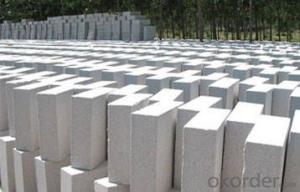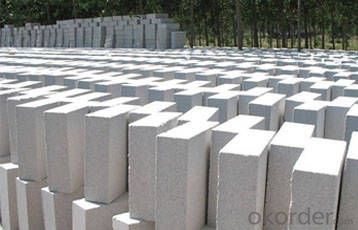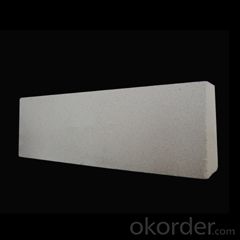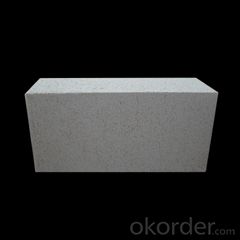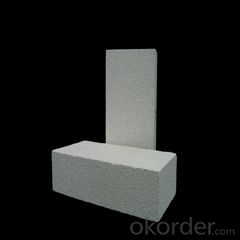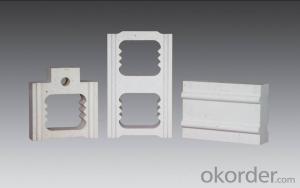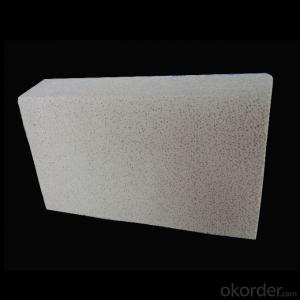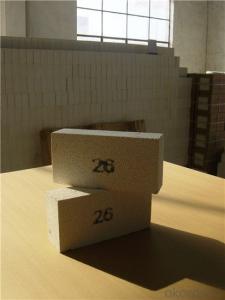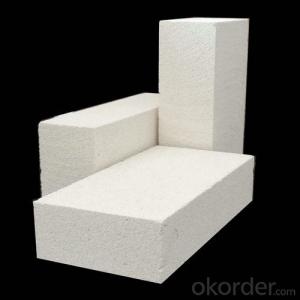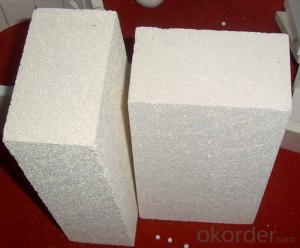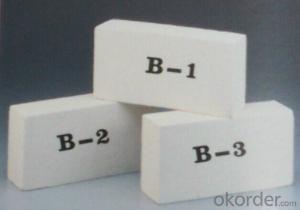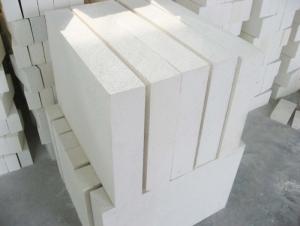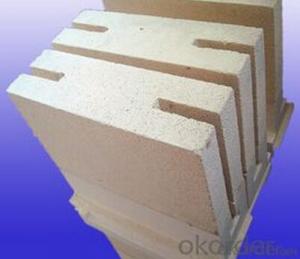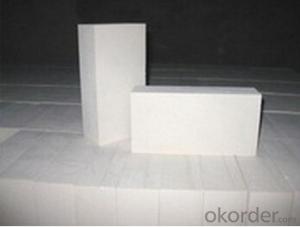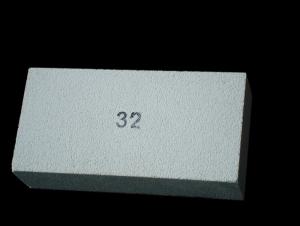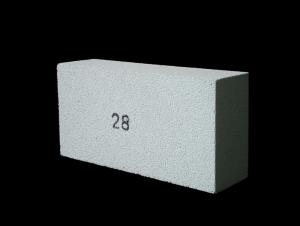Insulating Fire Brick Mullita Ladrilo Refractario Refractarios Aislantes JM 30
- Loading Port:
- Shanghai
- Payment Terms:
- TT OR LC
- Min Order Qty:
- 5000 kg
- Supply Capability:
- 5000000 kg/month
OKorder Service Pledge
OKorder Financial Service
You Might Also Like
Mullita ladrillo refractario refractarios aislantes JM 23
Aislamiento de calor de la serie okorder ladrillo
La serie okorder ladrillo es un eficaz aislamiento térmico, ahorro de energía, baja en carbono, la protección del medio ambiente avanzado, de acuerdo a la norma ASTM la fabricacion de productos.Okorder serie productos son mejores Li Ning y aislamiento en todo tipo de hornos industriales en el sector metalurgico, aluminio, petroquímica, energía eléctrica y materiales de cerámica de vidrio.Pueden ser utilizados como parte de la capa de aislamiento termico o non - Fusion.Los productos han sido ampliamente utilizados en el horno, logra resultados satisfactorios.
Aplicación de la preservación del calor de ladrillo
Industria metalurgica: Blast Furnace, hot alto horno, horno de calefaccion, etc.
Industria petroquímica: etileno horno horno de cracking, producción de hidrógeno, reformador primario, horno de calefaccion, etc.
Industria: horno de rodillos de cerámica, horno, etc.
Industria del vidrio: vidrio horno regenerador, etc.
Industria de carbono: carbono horno, etc.
Sector de la electrólisis de aluminio: aluminio reducción celular, etc.
Otras industrias: horno de tunel, Servicio de horno, etc.
Ventajas de ladrillo del aislamiento de calor
Baja conductividad térmica: mayor porosidad traerá buen aislamiento termico, ahorro de energía.
Alta resistencia al aplastamiento: alta resistencia al aplastamiento, la estabilidad de volumen.
Almacenamiento de calor: pequeños de almacenamiento de calor bajo para absorber más calor, ahorro de efecto es evidente.
Gao Chundu: hierro, metal alcalino de bajo contenido de impurezas.
El tamaño exacto: tamaño de ladrillo precision de procesamiento, forma especial de corte y molienda, acelerar el ladrillo.
Foto de ladrillo aislante
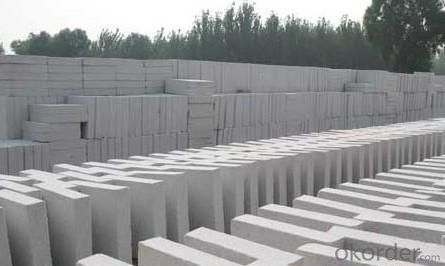
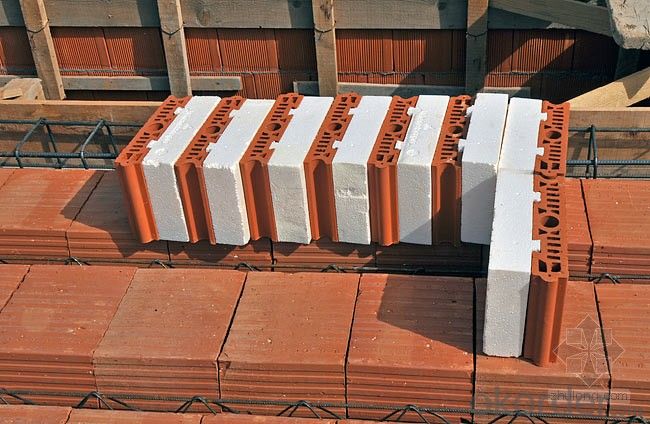

Problema común soluciones
1.¿Que productos tienes?
Disponemos de todo tipo de ladrillos refractarios, refractarios materiales de fundicion, mortero, cemento, productos de fibra cerámica, etc.
O usted puede hojear nuestros productos a elegir lo que usted necesita.
2.¿Cómo controlar la calidad del producto?
Con sistema de estricto control de calidad en la seleccion de materiales y el proceso de producción, tenemos la calidad de materiales refractarios y productos de fibra cerámica para satisfacer las necesidades de los clientes.
Desde la seleccion de materias primas, la calidad de nuestro control para empezar.El certificado de calidad de la materia prima es necesaria, cada lote de los productos serán probados en el uso de la línea.En el proceso de producción, el control de calidad por los trabajadores, y luego cada pieza de la clasificación, y mediante la supervisión de la calidad y la inspección.
3.¿Me puedes dar una breve introducción a la aplicación de su producto?
Mi empresa se dedica principalmente en refractarios en el acero, cemento, vidrio, cerámica, petroquímica, energía eléctrica y otras industrias.
4.¿Qué información necesitas si te necesito?
Con el fin de seleccionar los productos adecuados, que nos proporcionará la información, tales como los Estados Unidos, datos técnicos, cantidad de pedido, la aplicación del producto, etc.
Si usted tiene alguna pregunta, por favor pongase en contacto con nosotros.
- Q: Are insulating fire bricks resistant to chemical attack?
- Yes, insulating fire bricks are generally resistant to chemical attack. They are designed to withstand high temperatures and are made from materials that are chemically inert, making them suitable for various industrial applications where exposure to chemicals is a concern. However, the specific resistance may vary depending on the type of chemical and concentration, so it is important to consider the specific chemical environment when selecting insulating fire bricks.
- Q: Are insulating fire bricks suitable for use in autoclaves?
- No, insulating fire bricks are not suitable for use in autoclaves. Autoclaves require materials that can withstand high temperatures and pressure, while insulating fire bricks are designed for insulation purposes and may not have the necessary strength and durability.
- Q: Can insulating fire bricks be used in metal smelting furnaces?
- Yes, insulating fire bricks can be used in metal smelting furnaces. Insulating fire bricks are designed to have low thermal conductivity, which means they can effectively retain heat and prevent heat loss from the furnace. This makes them ideal for use in metal smelting furnaces, where high temperatures need to be maintained for extended periods of time. Additionally, insulating fire bricks are resistant to thermal shock and can withstand the harsh conditions and rapid temperature changes that occur during metal smelting processes. They are also lightweight, making them easier to handle and install in the furnace. Overall, insulating fire bricks are a suitable choice for use in metal smelting furnaces to improve energy efficiency and increase the lifespan of the furnace.
- Q: How do insulating fire bricks compare to other insulation materials?
- Insulating fire bricks are highly effective insulation materials that offer several advantages over other insulation materials. First and foremost, insulating fire bricks have excellent thermal properties, meaning they can efficiently prevent the transfer of heat. They have a low thermal conductivity, which allows them to effectively insulate against high temperatures. This makes them ideal for use in applications where heat retention is crucial, such as furnaces, kilns, and fireplaces. Compared to other insulation materials like fiberglass or mineral wool, insulating fire bricks are much more durable and long-lasting. They can withstand extremely high temperatures without losing their insulating properties or structural integrity. This durability makes them a cost-effective choice since they require less frequent replacement. Another advantage of insulating fire bricks is their ability to resist chemical attack and wear. They are resistant to acids, alkalis, and other corrosive substances, making them suitable for applications involving harsh chemicals or environments. Furthermore, insulating fire bricks have a high compressive strength, allowing them to bear heavy loads without cracking or breaking. This makes them suitable for use in structural applications where weight-bearing capacity is essential. In terms of installation, insulating fire bricks are easy to work with. They can be cut, shaped, and installed using basic tools, allowing for customization and flexibility in different applications. They are also lightweight, which simplifies the installation process and reduces the overall weight of the structure. Overall, insulating fire bricks offer superior insulation properties, durability, resistance to chemicals, and ease of installation compared to other insulation materials. Their ability to withstand high temperatures, resist wear and tear, and provide long-lasting insulation make them an excellent choice in various industrial and domestic settings.
- Q: Are insulating fire bricks resistant to UV radiation?
- Insulating fire bricks are not typically designed to be resistant to UV radiation. UV radiation from the sun can cause degradation and discoloration of many materials, including fire bricks. Therefore, it is recommended to protect insulating fire bricks from direct exposure to UV radiation, such as by using a protective coating or covering when they are used in outdoor applications. Additionally, prolonged exposure to UV radiation can also affect the thermal and insulating properties of fire bricks, potentially reducing their effectiveness over time. Therefore, it is important to consider UV protection measures when using insulating fire bricks in applications where they may be exposed to direct sunlight.
- Q: Are insulating fire bricks fire-rated?
- Yes, insulating fire bricks are fire-rated. They are specifically designed to withstand high temperatures and provide excellent thermal insulation in various applications. These bricks are made from a special type of ceramic material with low thermal conductivity, which allows them to retain heat and prevent it from transferring to the surrounding areas. This property makes them highly resistant to fire and helps protect the structures they are used in. Insulating fire bricks are commonly used in furnaces, kilns, fireplaces, and other high-temperature environments where fire protection is crucial.
- Q: Can insulating fire bricks be used in the construction of hot air generators?
- Indeed, the utilization of insulating fire bricks is applicable in the fabrication of hot air generators. Specifically engineered to endure extreme temperatures and deliver exceptional thermal insulation, insulating fire bricks are well-suited for incorporation into hot air generators. These generators necessitate insulation to uphold elevated temperatures and avert heat dissipation. By diminishing heat transfer to the surroundings, insulating fire bricks effectively enhance the efficiency and functionality of hot air generators. Furthermore, their lightweight nature, effortless installation, and long-lasting durability contribute to their widespread adoption in diverse industrial sectors, including the construction of hot air generators.
- Q: Do insulating fire bricks have a high fire resistance rating?
- Yes, insulating fire bricks have a high fire resistance rating. Insulating fire bricks are specially designed to withstand high temperatures and provide excellent insulation against heat transfer. They are made from high-purity refractory materials, such as alumina and silica, which have a high melting point and can withstand extreme heat. These bricks are capable of withstanding temperatures of up to 3000°F (1650°C) and have a thermal conductivity that is much lower than regular bricks or other materials. This makes them ideal for use in applications where high fire resistance is required, such as in industrial furnaces, kilns, fireplaces, and chimneys. Additionally, their insulating properties help to reduce heat loss, making them energy-efficient and cost-effective.
- Q: Can insulating fire bricks be used in outdoor applications?
- Insulating fire bricks are specifically designed for high-temperature applications and are commonly used in indoor environments such as kilns, furnaces, and ovens. While they are not typically recommended for outdoor applications, there are certain circumstances where they can be used with caution. Insulating fire bricks are made from lightweight refractory materials that provide excellent insulation and heat resistance. However, they are not as durable or weather-resistant as other types of bricks, such as clay or concrete bricks, which are more suitable for outdoor use. In outdoor applications, insulating fire bricks may be exposed to harsh weather conditions, including rain, snow, extreme temperatures, and UV radiation, which can cause them to deteriorate and lose their insulating properties over time. Additionally, these bricks are more susceptible to cracking and damage due to thermal expansion and contraction caused by temperature fluctuations. If you need to use insulating fire bricks in an outdoor application, it is important to take extra precautions to protect them from the elements. This can include using weatherproof coatings or sealants to minimize water absorption and prevent damage from freezing and thawing cycles. It is also crucial to ensure proper drainage and ventilation to prevent moisture accumulation, as excessive moisture can compromise the insulation properties of these bricks. Overall, while insulating fire bricks can be used in outdoor applications under specific conditions, it is generally recommended to use more suitable materials for long-term durability and performance.
- Q: How do insulating fire bricks affect the overall efficiency of a heating system?
- Insulating fire bricks can significantly improve the overall efficiency of a heating system. Their high thermal resistance helps to minimize heat loss and increase heat retention within the system. This means that less energy is required to maintain the desired temperature, resulting in reduced fuel consumption and increased energy efficiency. Additionally, the insulating properties of fire bricks can also help to create a more balanced and consistent heat distribution, ensuring that the heating system operates more efficiently and effectively.
Send your message to us
Insulating Fire Brick Mullita Ladrilo Refractario Refractarios Aislantes JM 30
- Loading Port:
- Shanghai
- Payment Terms:
- TT OR LC
- Min Order Qty:
- 5000 kg
- Supply Capability:
- 5000000 kg/month
OKorder Service Pledge
OKorder Financial Service
Similar products
Hot products
Hot Searches
Related keywords
